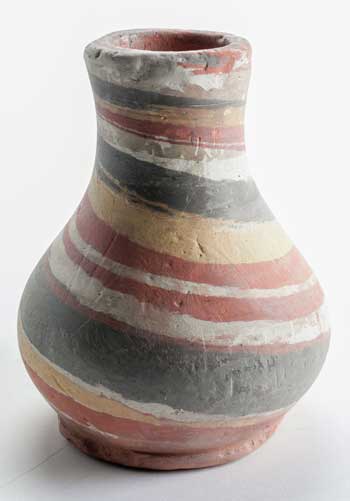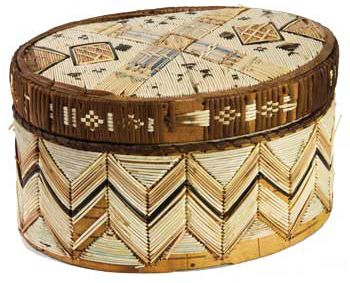by Carlene Phillips ·
Friday, July 5, 2024
Two exhibits in the Four Seasons Gallery at The Trustees of Reservations Fruitlands Museum portray the reinterpretation of the museum’s rich collection of Native American art. Objects collected by Clara Endicott Sears in the early 20th century are shown alongside more contemporary pieces from artists across the country. The show is curated by Tess Lukey, an Aquinnah Wampanoag tribal member who was hired by The Trustees in October 2022 as the associate curator of Native American art and charged with reinterpreting the Fruitlands collection through a Native lens.
In talking about the exhibit, Michael Busack, director of museums of The Trustees, said that for several years Fruitlands struggled to tell the Native story in a more authentic way. Members of local Indigenous communities were invited to give input. “We stopped, we listened, and we went forward,” said Busack of the process. He said he is proud of his team, headed by Lukey, and how they “raised the perspectives from which to tell the story.”

A clay vase from Martha’s Vineyard. �(Courtesy photo)
The exhibit in the larger gallery is titled “Across Boundaries Across Barriers.” In a phone conversation, Lukey said so often museums, academics, and others want to fix Indigenous people and objects in a specific time and place, “to separate them out.” She deliberately chose not to organize the exhibit geographically “so as not to perpetuate a very anthropological way of understanding tribal communities.” Rather, she said, “The exhibit is grounded in Indigenous ways of knowing and their living presence.” She said she really enjoyed getting to know the slightly over 1,000 artworks and belongings in the Native American collection. “I’m an objects girl,” she said. She likes “the materiality” of them, and as a self-described lifelong learner, she liked connecting them to the homelands from which they originated.
In the back study room of the gallery, Native visitors are invited to make a medicinal blessing—sprigs of tobacco, sage, sweetgrass, and cedar tied up in a small piece of cloth—as a gift to one of the objects. Lukey said the objects are far from their homelands; “their souls are tied to them” and we need to show “care for them.” This idea of the living spirit within the objects is expressed in a line from the poem “Who We Are:” “We are the Cedar Basket/sewn from the Roots of the Universe.” The poem, hanging in the gallery entryway, is a welcome to the Nipmuc homelands, land on which Fruitlands exists, by Lukey’s colleague, Larry Spotted Crow Mann, and it captures much of the spirit of the exhibits.
Some objects have a named artist, and many are by “artist once known.” Lukey said the usual label, “unknown artist” does not show proper respect for the artist who was once alive. Her term “gives the artist back his humanity.” In a similar way, a line from Mann’s poem captures a living presence: “And through our Ancestor’s voice comes the authority, and authenticity/to allow the story to continue to be told.”
A storyboard in the hallway describes Lukey’s vision for the exhibit, her intention “to use the medicine wheel to move beyond the traditional boundaries of place and time.” As a whole, the medicine wheel represents the cycle of life through which everything passes and the continuity of all things. “It has concepts and ways of knowing that inform every day of your life,” said Lukey. The exhibit uses the medicine wheel as a framework to connect artworks with a direction of the wheel—north, south, east, west, and center, which contains sky and earth. Each of these directions has certain qualities or guiding principles associated with it, such as a stage of life, an aspect of nature, a facet of human nature, a moral guideline.
Artworks are on the walls and in freestanding cases of different sizes and shapes, grouped so as to connect with one of the directions. The arrangement of cases creates a sense of flow.
This connection of artworks to the wheel is clear in the section of the gallery labeled “East.” Called “Radiant Traditions,” the storyboard describes East as the place of light, of energy and movement. The directions or principles associated with it are balance, growing, being changed by your experiences. The artwork by Tom Patterson is one of the most striking pieces in the exhibit. Called “Raven Releases the Light,” it is a large wooden mask with strings that open the two sides of a large beak to expose a sun face, with its nose the beak of a bird. It is mostly black, with accents of yellow and red. The raven is a symbol of transformation and magic, with connections to the spiritual world, and the raven mask captures the physical and symbolic meanings of East on the medicine wheel.
In South, “Flowing Connections,” the element of water symbolizes nurturing and growth. “Through water the life cycle is awake and dancing.” Several ollas, or water jars, of clay and fiber are objects connected to the function of water. Other works use imagery of the surface of water.

Quillbox made of birch bark, spruce, and porcupine quills. �(Courtesy photo)
“Cycles of Renewal” is the West quadrant, the place of adulthood where we meet fulfillment in life and find our meaning. The works represent stages of our lives and how each aspect of self is reflected in our appearance. A large, colorful photograph, wall hanging, and clothing reflect personal expressions of self. A 1985 Pueblo clay olla uses acrylic paint to depict traditional dancers in colorful dress.
The North section, “Roots and Reflection,” is a place of rest and contemplation, with connection to natural materials or botanical elements, and its directions are strength, resilience, and connection to the land. A striking example of this theme is a huge burl bowl, carved from dark wood, perhaps walnut. It is dated from the early 20th century and labeled “by a Seneca artist once known.” A long, curved cribbage board, 1920 Alaska, made from walrus ivory, is raised up over a mirrored surface so that the underside is visible. Engraved images show hunting scenes. Not only are these objects made from materials from nature but they are particularly strong and resilient.
At the Center is “Embodied Homelands.” At the heart of the medicine wheel is the center of all the knowledge in the universe; it is where the wheel comes into balance. The works are from tribal communities of the Northeast and represent the earth, skies, and waters of New England. Lukey writes that in Wampanoag there is no word for art, no separation between art and life.
“From earth to sky, skyscrapers to the wrinkles on my grandmother’s face, art is everywhere.”
Lukey selected items from the collection that tell the stories of the communities from which they originate. A bandolier bag from 1900 is elaborately decorated with glass beads. It depicts both the life cycle of the plant and also the actual plants from the artist’s New England environment. A 2020 bear and sun necklace with a quahog shell shows the artist Elizabeth Perry’s connection to the ocean, particularly in Massachusetts.
One object is especially “close to my heart,” said Lukey: a small vase with a lovely design in muted colors. It is not only because she herself is a ceramic artist, but also because the clay used for the vase is the same clay as that “where her people were shaped,” the Aquinnah community of Martha’s Vineyard. It’s her origin story; “I am made with that land.”
In the smaller gallery is the exhibit “Place of Intersection: Survivance in the American West.” The storyboard describes the 19th-century concept of manifest destiny as the driving force of westward expansion. “To reflect the exotic nature of these newly discovered places, artists created static images, reducing Indian cultures and people into something to be gawked at.” Some Hudson River School paintings Sears collected show an idealization of Native culture and “a people of little dimension, frozen in time and place.”
To counter these stereotypes, Lukey has paired idealized paintings with works of Native communities to show the reality of the culture. Artworks continued to be made; “making is an art of survivance.” A painting, “Indian Encampment,” from 1860 shows a romanticized scene of life on the Plains, with tipi-like structures, painted hides, and shields. In contrast, items like an early 20th-century saddle pad of leather intricately decorated with glass beads and a small bag with two crossed, beaded American flags show the real culture, one that was adapting, moving forward, engaging in commerce.
Busack said his team continues to discuss the pros and cons of further changes to the Native American artworks in the Fruitlands collection. It’s complicated, he said, but “art is at its best when it’s inspiring questions.”